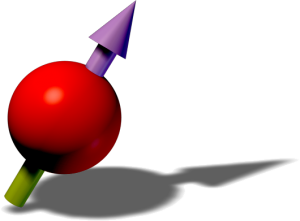by Lauritz Klaus
Abstract:
Ultracold quantum gases are driving the study of new exotic phases of matter and are promising platforms for quantum simulations. Most quantum gas experiments have focused on working with alkali and alkaline earth atoms with predominantly short-range isotropic interactions. More recently, the creation of quantum gases of strongly magnetic atoms such as dysprosium and erbium has allowed the study of systems with additional dipole-dipole interactions. These interactions are longrange and anisotropic. A hallmark feature of superfluids undergoing rotation are quantized vortices. These vortices appear in quantum gases as holes in the density distribution and have been studied since the early days of the field. They play a crucial role not only in quantum gases but also in many other systems, such as superconductors or neutron stars. This thesis has two main topics. The first part reports on the first nucleation of quantised vortices in a rotating dipolar Bose-Einstein condensates. To achieve this, a new technique has been developed, called magnetostirring, where angular momentum is imparted to the dipolar condensate by exploiting the anisotropy of the dipole-dipole interactions. It is also shown that the vortices arrange themselves in a striped configuration along an external magnetic field, in contrast to the triangular Abrikosov lattice for non-dipolar BECs. The second topic concerns the superfluid nature of the quantum gas in the supersolid state. When the contact and dipolar interaction strengths are similar, trapped dysprosium spontaneously exhibits spatial modulation and is globally coherent. This state is called supersolid, because it shows both solid and superfluid properties. The reported work is concerned with confirming the superfluid nature of the supersolid. The foundation for this work is the first realisation of a cylindrical symmetric 2D supersolid. An approach to quantify the superfluid fraction of this state is described, following a proposal by Leggett, by exciting angular oscillations such as the scissors mode. However, the complex excitation spectrum of the supersolid makes it difficult to access the superfluid fraction experimentally. Finally, the direct proof of the superfluid nature is given by the observation of quantised vortices in the rotating supersolid. This work opens the door to further studies of vortices in supersolid systems and may in the future serve as a test bed for other complex vortex systems, such as superconductors or neutron stars.
Reference:
Vortices in Dipolar Quantum Gases of Dysprosium,
Lauritz Klaus,
PhD Thesis, 2025.
Lauritz Klaus,
PhD Thesis, 2025.
Bibtex Entry:
@article{KlausPhD,
title = {Vortices in Dipolar Quantum Gases of Dysprosium},
author = {Lauritz Klaus},
journal = {PhD Thesis},
year = {2025},
month = {Jan},
abstract = {Ultracold quantum gases are driving the study of new exotic phases of matter and
are promising platforms for quantum simulations. Most quantum gas experiments
have focused on working with alkali and alkaline earth atoms with predominantly
short-range isotropic interactions. More recently, the creation of quantum gases
of strongly magnetic atoms such as dysprosium and erbium has allowed the study
of systems with additional dipole-dipole interactions. These interactions are longrange
and anisotropic.
A hallmark feature of superfluids undergoing rotation are quantized vortices. These
vortices appear in quantum gases as holes in the density distribution and have been
studied since the early days of the field. They play a crucial role not only in quantum
gases but also in many other systems, such as superconductors or neutron stars.
This thesis has two main topics. The first part reports on the first nucleation of
quantised vortices in a rotating dipolar Bose-Einstein condensates. To achieve this,
a new technique has been developed, called magnetostirring, where angular momentum
is imparted to the dipolar condensate by exploiting the anisotropy of the
dipole-dipole interactions. It is also shown that the vortices arrange themselves in a
striped configuration along an external magnetic field, in contrast to the triangular
Abrikosov lattice for non-dipolar BECs.
The second topic concerns the superfluid nature of the quantum gas in the supersolid
state. When the contact and dipolar interaction strengths are similar, trapped
dysprosium spontaneously exhibits spatial modulation and is globally coherent. This
state is called supersolid, because it shows both solid and superfluid properties. The
reported work is concerned with confirming the superfluid nature of the supersolid.
The foundation for this work is the first realisation of a cylindrical symmetric 2D
supersolid. An approach to quantify the superfluid fraction of this state is described,
following a proposal by Leggett, by exciting angular oscillations such as the scissors
mode. However, the complex excitation spectrum of the supersolid makes it difficult
to access the superfluid fraction experimentally. Finally, the direct proof of the
superfluid nature is given by the observation of quantised vortices in the rotating
supersolid. This work opens the door to further studies of vortices in supersolid
systems and may in the future serve as a test bed for other complex vortex systems,
such as superconductors or neutron stars.},
url = {https://www.erbium.at/FF/wp-content/uploads/2025/08/Lauritz_Klaus_PhDThesis.pdf},
}
